Football/media star O.J. Simpson, who became a famous mug shot for domestic violence and a double murder charge, has died of cancer
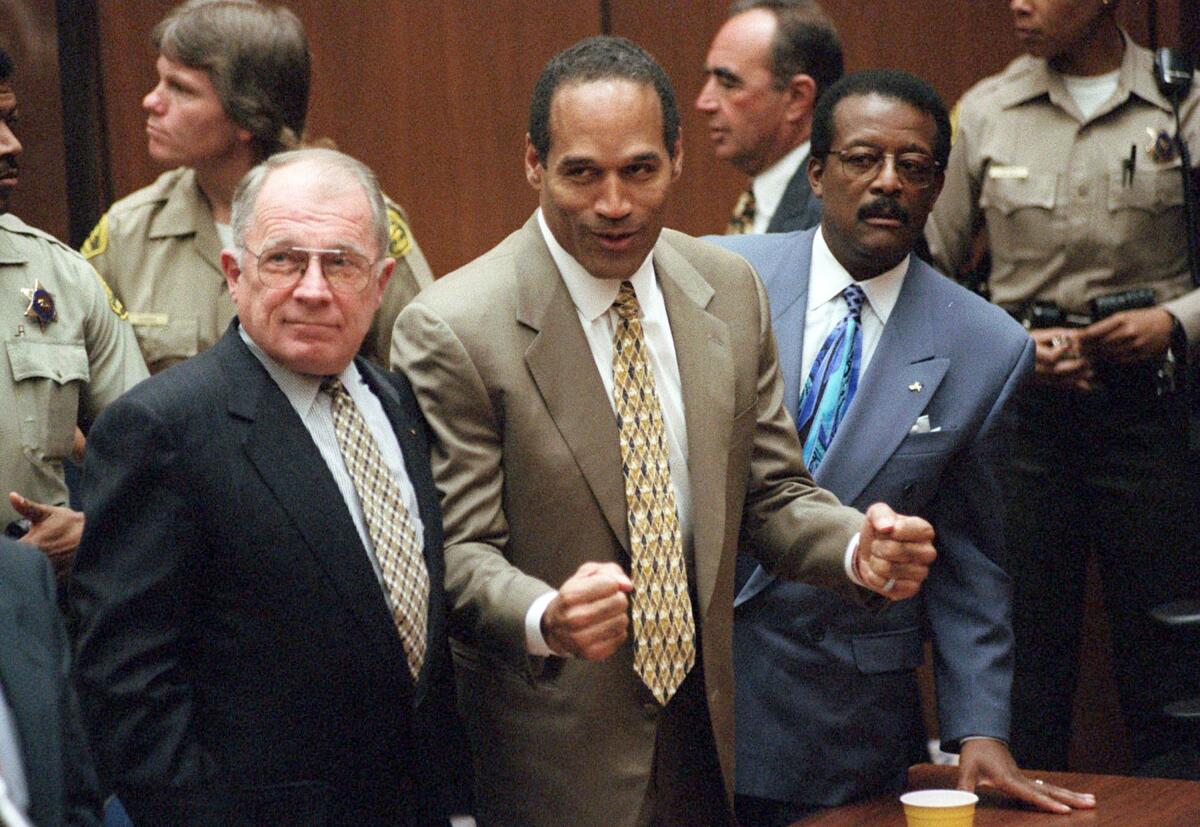
Oct. 1995 — O.J. Simpson reacts as he is found not guilty in the death of his ex-wife Nicole Brown Simpson and her friend Ron Goldman in Los Angeles. Defense attorneys F. Lee Bailey, left, and Johnnie L. Cochran Jr. surround him. (Myung J. Chun / Pool)
Elaine Woo (LA Times) — O.J. Simpson, whose rise and fall from American football hero to accused murderer to prison inmate fueled a rancorous public drama that obsessed the nation and spawned debates over race, wealth, justice and retribution, has died of cancer, according to a family member’s statement on X.
It was not immediately clear where Simpson died, but his family said he was surrounded by his children and grandchildren when he died on April 10. He was 76.
Simpson was once the country’s most admired athlete, a formidable running back who broke records with grace and determination. He became a crossover star, lending his handsome face and affable personality to the slapstick “Naked Gun” movies and classic television commercials for Hertz.
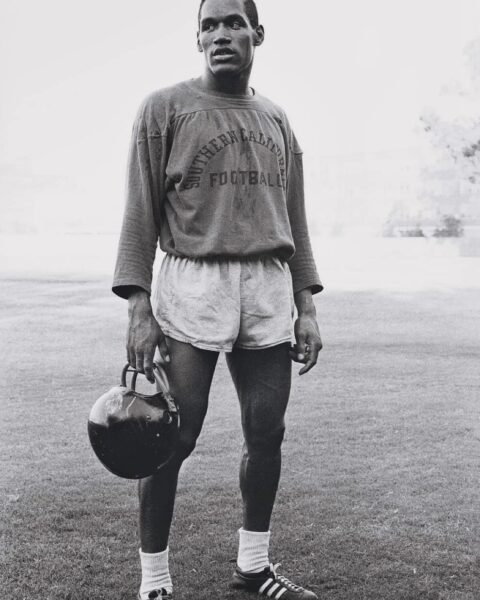 Although widely presumed to be guilty of the killings, the former USC Heisman Trophy winner was acquitted in 1995 in a spectacular trial that was rife with vexing questions, none more divisive than the one posed by Simpson’s defense team: whether a Black man in America — even one who had crossed racial barriers and attained significant wealth and status — could be tried without prejudice for the slayings of a white person. Polls showed deep fissures between Black people and white people on the question of his innocence. When a predominantly Black jury set him free, it drew those racial suspicions into even sharper relief.
Although widely presumed to be guilty of the killings, the former USC Heisman Trophy winner was acquitted in 1995 in a spectacular trial that was rife with vexing questions, none more divisive than the one posed by Simpson’s defense team: whether a Black man in America — even one who had crossed racial barriers and attained significant wealth and status — could be tried without prejudice for the slayings of a white person. Polls showed deep fissures between Black people and white people on the question of his innocence. When a predominantly Black jury set him free, it drew those racial suspicions into even sharper relief.
“The only reason that we will care about O.J. Simpson 10 years after, 20 years after, is what it told us about race in this country,” said the New Yorker’s Jeffrey Toobin.

Simpson’s acquittal was only the first chapter in a long legal saga. In 1997, a predominantly white jury in Santa Monica found him liable for the deaths in a civil suit brought by the Brown and Goldman families. Ordered to pay the families $33.5 million in damages, Simpson gave up his Brentwood estate and moved to Florida, in large part to evade the civil judgment.
His desire to shield his assets set in motion the events that ultimately would bring him down: the robbery in a cheap Las Vegas hotel room in 2007. After a short trial that received minimal media coverage, the judge pronounced him guilty, 13 years to the day after the so-called “Trial of the Century” had set him free.
Orenthal James Simpson was born July 9, 1947, in a housing project in the depressed Potrero Hill section of San Francisco. He was the second of four children of Jimmie, a bank custodian, and Eunice, a night orderly at San Francisco General Hospital. He saw little of his father after his parents separated when he was 5. Simpson said in a 1977 Parents magazine interview that he resented his father’s absence, “especially when I became a teenager and was trying to find out who I was.”
He had rickets as a child and was left with spindly, bowed legs that attracted taunts from neighborhood kids. His mother fashioned a set of homemade leg braces that helped him improve enough to play football at Galileo High School. But his other extracurricular activity was stealing hubcaps and pies with a gang called the Persian Warriors. “I was always the leader — the baddest cat there,” he recalled.
He shaped up enough to enter San Francisco City College, where he scored 54 touchdowns in one season. At USC, he led the nation in rushing, running for 3,423 yards in two seasons, and in 1968, his senior year, he captured the highest honor in college football, the Heisman Trophy. He’d been a runner-up the year before.
He was snapped up by the Buffalo Bills in the 1969 National Football League draft but became problematic immediately when he demanded the largest contract in professional sports in the U.S. — $650,000 paid over five years. Initially Simpson disappointed but ended up leading the team in rushing for nine straight years.
In 1973, he broke NFL records by becoming the first runner to surpass 2,000 yards in a single season with a then-record 2,003 yards and broke Jim Brown’s single-season rushing record, once thought unobtainable. He was NFL Player of the Year in 1972, 1973 and 1975 but reached the playoffs only once and never got to the Super Bowl.
His style was idiosyncratic, known for twisting, fleet-footed runs that stymied the opposition. “O.J. gets right on top of you, looks you in the eye and then — pfft — he’s gone,” former Pittsburgh Steelers defensive lineman Joe Greene told Newsweek in 1975.
He went by O.J., but he was also known as “The Juice.”
In addition to his athletic gifts, he had what Newsweek’s Pete Axthelm called “an expanding, well-rounded personality” that was attractive to Hollywood moguls and Madison Avenue advertisers.
By the mid-1970s, the charismatic sports icon was acting in movies such as “The Towering Inferno” and “The Cassandra Crossing” and hurtling through airports as the star of a Hertz car rental television campaign.
He retired from football in 1979 after an undistinguished season with the San Francisco 49ers, the same year his 12-year marriage to the former Marguerite L. Whitley ended in divorce.
His first marriage produced three children: Arnelle, Jason and Aaren. In August 1979, Aaren, then 23 months old, drowned in the family swimming pool. Simpson rarely discussed the accident in public.
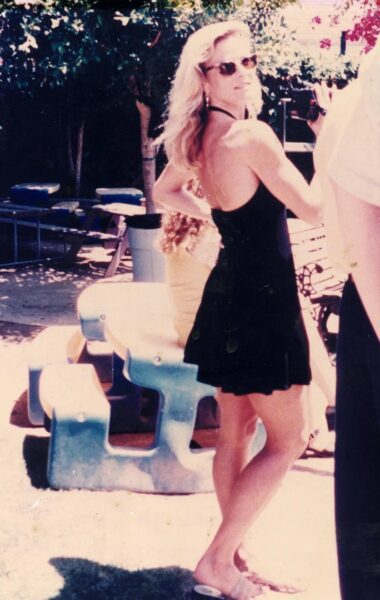 By then, Simpson was already dating Nicole Brown, whom he had met in 1977 when she was a waitress at a Beverly Hills nightclub, the Daisy. A former homecoming princess at Dana Hills High School in Orange County, she was blond, beautiful and 12 years his junior.
By then, Simpson was already dating Nicole Brown, whom he had met in 1977 when she was a waitress at a Beverly Hills nightclub, the Daisy. A former homecoming princess at Dana Hills High School in Orange County, she was blond, beautiful and 12 years his junior.
She dropped out of Saddleback College in Mission Viejo to move in with the famous running back and, after living together for several years, they were married on Feb. 2, 1985. Their first child, Sydney, was born that October. A son, Justin, was born in 1988.
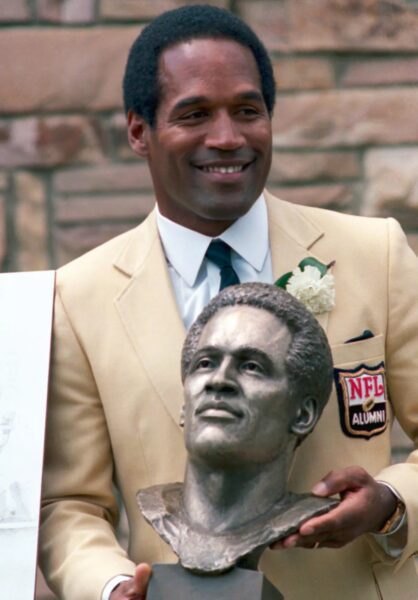 When Simpson was inducted into the Pro Football Hall of Fame in 1985, he thanked Nicole, noting that she entered his life “at what is probably the most difficult time for an athlete, at the end of my career. She turned those years into some of the best years I have had in my life.”
When Simpson was inducted into the Pro Football Hall of Fame in 1985, he thanked Nicole, noting that she entered his life “at what is probably the most difficult time for an athlete, at the end of my career. She turned those years into some of the best years I have had in my life.”
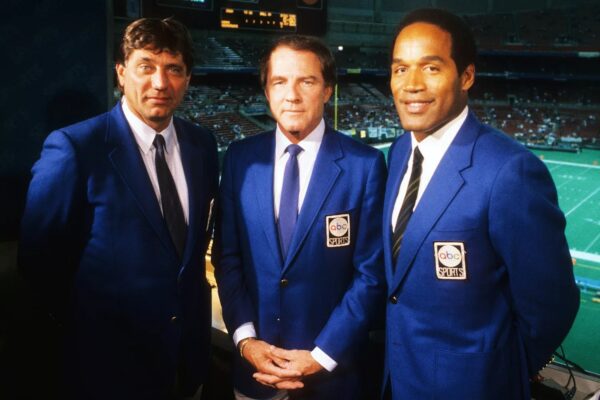 He became a sports broadcaster for NBC and ABC, including a brief run as a replacement for broadcaster Howard Cosell on “Monday Night Football,” here with Joe Namath and fellow Trojan Frank Gifford.
He became a sports broadcaster for NBC and ABC, including a brief run as a replacement for broadcaster Howard Cosell on “Monday Night Football,” here with Joe Namath and fellow Trojan Frank Gifford.
His pursuits enabled him to provide Nicole with a glamorous life. In addition to the $5-million Brentwood estate, they had second homes in Laguna Beach and New York, his-and-hers Ferraris and frequent vacations to Vail, Aspen and Hawaii.
But theirs was a volatile relationship. They fought and made up with regularity.
On New Year’s Day in 1989, however, an anonymous 911 call summoned police to the Simpsons’ home. When police arrived at 3:30 a.m., Nicole rushed out from the bushes where she had been hiding. Her lip was split, her eye was black and a handprint was visible on her neck. “He’s going to kill me, he’s going to kill me,” she cried, according to the police report. The famous former athlete emerged from the house, yelling, “I got two women, and I don’t want that woman in my bed anymore.”
Simpson pleaded no contest to domestic violence and was ordered to pay a $700 fine, obtain psychiatric counseling and perform 120 hours of community service. He also was placed on two years’ probation. The couple issued a statement, calling the altercation “an isolated and unfortunate incident.”
In 1992, the couple divorced. Simpson kept the Brentwood house while Nicole and the children moved into a townhouse a few miles away. He started to date model Paula Barbieri, but friends said he remained obsessed with his former wife.
On a 911 tape from Oct. 25, 1993 — widely aired after she and Goldman were killed — Nicole is heard pleading with the operator for help. She said Simpson had broken down her door and was “going nuts.”
There were several unsuccessful attempts at reconciliation. In late May, Nicole told her family that she was done with Simpson.
On June 12, 1994, Simpson attended a school dance recital for his daughter, Sydney. According to witnesses, he sat alone and glared at his ex-wife during the performance. When she left for a post-recital dinner party with her children, Simpson was not invited.
This much is certain about what happened over the next hours: After dining at a neighborhood restaurant, Mezzaluna, Nicole took the kids to get Ben & Jerry’s ice cream. Back home, her mother called around 9:40 p.m. to ask Nicole to retrieve a pair of eyeglasses she had left at the restaurant. Nicole reached her friend, Goldman, who was a waiter there. He said he would drop the glasses off after he left work around 10 p.m.
A little more than an hour later, a blood-streaked Akita dog would lead a good Samaritan to a grisly discovery: two bodies covered in blood outside Nicole’s Bundy Drive condo. When police arrived, they found Nicole, 35, with a deep, wide gash across her throat. Goldman, 25, had stab wounds to his throat, lungs and abdomen.
The children were asleep upstairs.
When the police tried to notify Simpson, they learned he had left on an 11:45 p.m. flight to Chicago for a meeting with Hertz executives. By the next day, his Rockingham Road estate had become a crime scene.
Police had discovered blood stains on the driveway and a bloody glove in the yard that appeared to match one recovered on Bundy Drive. They found traces of blood on a white Ford Bronco parked haphazardly at the curb. The estate’s famous resident quickly became the focus of the investigation.
The enduring image from the days immediately after the slayings would be the Bronco cruising down eerily empty freeways, trailed by a fleet of police cars. For seven hours on Friday, June 17, the celebrated former athlete eluded authorities who had planned to arrest him that morning. Behind the wheel of the Bronco was Simpson’s boyhood friend and former NFL colleague Al “A.C.” Cowlings. In the back, reportedly holding a gun to his own head, was Simpson.
Tipped by news reports, crowds gathered along the Bronco’s route as it sliced through Orange and Los Angeles counties. Some bystanders cheered, “Go, O.J., go!” as the Bronco passed, as if they were witnessing one of his legendary runs on the football field. Others held up signs: “We Love the Juice,” “Save the Juice.”
An estimated 95 million people — bigger by several million than the number who tuned into the Super Bowl that year — watched the slow-speed pursuit on television. Later, some commentators would trace the roots of reality TV to the surreal, 60-mile car chase that transfixed the nation and ended without violence in Simpson’s driveway, where he finally surrendered.
“Don’t feel sorry for me,” Simpson said in a suicide note his friend and attorney Robert Kardashian read at a news conference earlier in the day. The note ended with a plea: “Please think of the real O.J., and not this lost person.”
Laurie Levenson, a Loyola Law School professor who became a fixture as an analyst for CBS during the trial, said the chase and the case became a cultural touchstone.
“He really does define the combination of modern pop culture with the modern justice system,” Levinson said. “He was the origin of reality TV. You followed the Bronco. You followed the trial. You followed everything after. It’s like the Bronco chase continues.”
The trial opened on Jan. 24, 1995, in the downtown Los Angeles courtroom of Judge Lance Ito, whose decision to allow the proceedings to be televised was later heavily criticized. Quickly dubbed the “trial of the century,” it offered a cast of slick lawyers — Johnnie L. Cochran Jr. and Robert Shapiro leading the defense and Marcia Clark and Christopher Darden for the prosecution — and intriguing supporting characters, from sympathetic sister Denise Brown to rumpled houseguest Kato Kaelin. Vanity Fair writer Dominick Dunne called the trial “a great trash novel come to life.”
With no murder weapon or eyewitnesses, the evidence was purely circumstantial. But Clark promised the jury that a trail of blood evidence would lead them directly from the gory crime scene to Simpson’s mansion. The prosecution presented DNA findings that the blood found next to the size-12 shoeprints leaving the scene belonged to Simpson (who wore size 12 shoes), that blood found on a sock in his bedroom belonged to Nicole and that blood detected in his Bronco belonged to Goldman.
As for motive, the prosecutors portrayed Simpson as a jealous man obsessed with his ex-wife and frustrated he could no longer control her through expensive gifts, threats and beatings. He killed Goldman, Darden said, “because he got in the way.”
The defense demolished the DNA evidence, arguing that police conspired to fabricate and contaminate evidence. It turned a key exhibit — the bloody glove — into a symbol of official malfeasance. Not only did Simpson’s lawyers allege that the glove found in their client’s yard that matched one found at the crime scene had been planted by a racist cop — Det. Mark Fuhrman, whose derogatory references to African Americans and boasts about manufacturing evidence were exposed in court — but the gloves didn’t even fit when Darden asked Simpson to try them on.
“They’re too small,” Simpson said, struggling to pull on the gloves. Those were the only words he uttered to the jury during the 10-month trial.
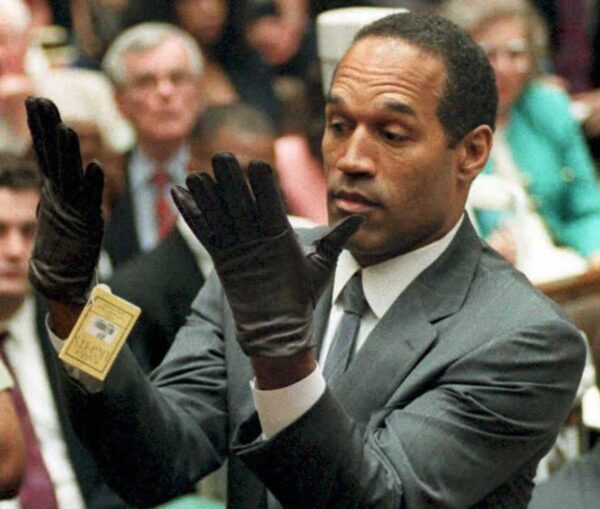 The dramatic demonstration gave Cochran the line that cemented his closing argument: “If it doesn’t fit,” he intoned, “you must acquit.”
The dramatic demonstration gave Cochran the line that cemented his closing argument: “If it doesn’t fit,” he intoned, “you must acquit.”
And less than a week later, the jury acquitted the celebrity defendant, after deliberating only three hours.
But Simpson was never truly free again.
The civil trial took place in 1996 and deepened the portrait of Simpson as an abuser. More liberal rules allowing hearsay evidence allowed lawyers for the Brown and Goldman families to use excerpts from Nicole’s diaries. The journal entries detailed incidents when Simpson terrorized her with a gun, shouted profanities at her, tried to coerce her into aborting their unborn son and threatened to turn her into the Internal Revenue Service.
This time, Simpson testified.
He denied ever hitting or beating Nicole. Instead, he offered a picture of himself as a concerned husband who nursed her through pneumonia after their divorce and worried about her even after he became involved with someone else.
But his testimony failed to convince the mostly white jury. After deliberating for three days, they returned a unanimous verdict against him. Finding him liable for the deaths of Nicole and her friend was the closest the legal system could get to branding him a murderer.
Simpson was forced to sell his Brentwood home of 20 years at auction several months later; it was razed in 1998. Two years later, he moved to Florida, where the laws made it easier for him to shield his remaining assets. He lived off his $19,000-a-month NFL pension and investments.
In 2006, he wrote “If I Did It,” a bizarre “fictional memoir” about how he might have committed the murders. His potential to profit from the book stirred such outrage that the original publisher, Judith Regan, was fired and thousands of copies were destroyed.
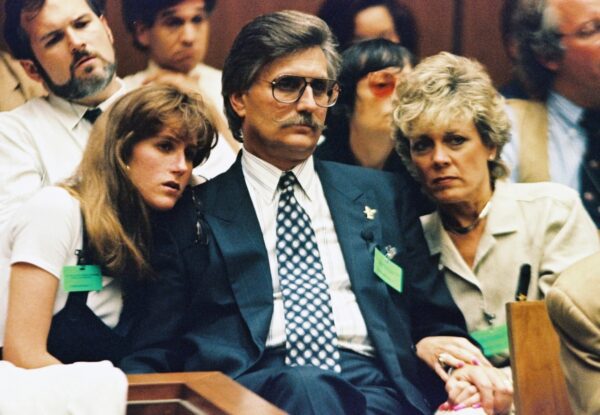 In an effort to collect on the civil verdict, Goldman’s father, Fred, gained the rights to the book and had it published in 2007. The book, which became a bestseller, featured Simpson’s original manuscript but with an introduction by the Goldmans, who viewed the story as Simpson’s confession. Taking the book away from Simpson was a coup for the Goldmans, whose lawyers constantly dogged him to turn over valuables.
In an effort to collect on the civil verdict, Goldman’s father, Fred, gained the rights to the book and had it published in 2007. The book, which became a bestseller, featured Simpson’s original manuscript but with an introduction by the Goldmans, who viewed the story as Simpson’s confession. Taking the book away from Simpson was a coup for the Goldmans, whose lawyers constantly dogged him to turn over valuables.
Fred Goldman later speculated that losing the book pushed Simpson over the edge.
On Sept. 13, 2007, he assembled a rogue’s gallery of ex-cons to confront memorabilia dealers Bruce Fromong and Alfred Beardsley, whom an intermediary had lured to a room at the Palace Station Hotel & Casino in Las Vegas. Told to expect a “mystery buyer,” they were stunned when Simpson burst into the room with his ragtag band of cohorts, two of whom brandished guns as Simpson demanded the return of a number of items he said belonged to him. He left with a bag full of mementos, including an All-American team football and three game balls inscribed with the dates he used them to break records.
Simpson was arrested three days later on charges including armed robbery and kidnapping.
At his trial, there were empty seats in the courtroom.
At his sentencing, Simpson was contrite.
“In no way did I mean to hurt anybody, to steal anything from anybody. I just wanted my personal things,” he told the judge after hearing his sentence. Then, with wrists shackled to a chain around his waist, he was taken to his cell.
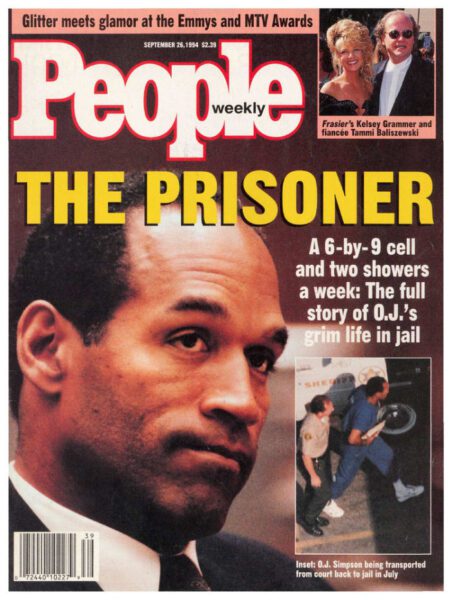 Long before the city woke up on a fall morning in 2017, Simpson walked out of Lovelock Correctional Center outside Reno, a free man for the first time in nine years. He didn’t go far, moving into a 5,000-square-foot home in Las Vegas with a Bentley in the driveway.
Long before the city woke up on a fall morning in 2017, Simpson walked out of Lovelock Correctional Center outside Reno, a free man for the first time in nine years. He didn’t go far, moving into a 5,000-square-foot home in Las Vegas with a Bentley in the driveway.
The media had been told he’d be released the following day, so he had the desert morning to himself as he was driven away. It was a final trick play for a man who’d spent a lifetime running away from trouble.
latimes.com
___________
TrojanDailyBlog members — We always encourage you to add factual information, insight, divergent opinions, or new topics to the TDB that don’t necessarily pertain to any particular moderator post or member comment.
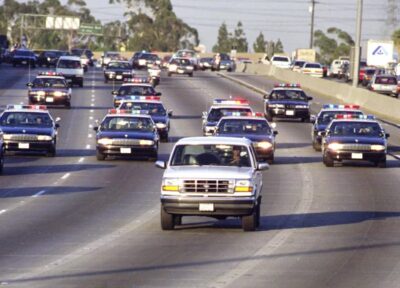
I thought hard and long about OJ. I think my feelings are best summarized in the movie “Amadeus”, which is about the life of one of the world’s greatest composers Wolfgang Amadeus Mozart, who is in my favorite composer. In the movie Mozart is presented as a truly gifted creator of music. In the movie, his ability to create music is compared to being divine like – an extremely rare gift from God. The movie also portrays Mozart and his wife as deeply flawed individuals, with Mozart being profane, impulsive, a drunkard, and completely irresponsible and his wife as an… Read more »
Nice post, sir. Might be the first reference to Mozart in TDB,
Well, that didn’t last long. USC DL Isaiah Raikes Enters NCAA Transfer Portal Again Former A&M defender Isaiah Raikes, who just transferred to USC in early January, is headed back in the portal after under four months with the Trojans. This is CFB’s new normal, and USC will certainly have a solid crack at many players to add to their roster next week when the portal officially opens. It looks to me like USC is weeding out players who don’t fit with the program’s new direction and focus on being a true competitor amongst the elite again. And the Trojans are… Read more »
See ya later. Thanks for the 5 or so practices. Next man up!
If I’m a coach looking at Raikes in the portal, I would ask myself, is he going to be a plus or a minus in the locker room? With this new system just like schools will get a reputation so will players. It will be interesting to see if and where he ends up.
When I see the careless attitude hovering over a sport we love, I remind myself what are we dealing with here? Young gifted atletes who were pampered from the childhood beginning and teaching them responsibility isn’t necessary so just expect entitlement you will get your way or you can take your ball and stomp home. I used to loathe what Ed O’Bannon started in suing for past NIL money UCLA made off his basketball there . But then his reason was after the fact what he “had done”and not what it is today in athletes are holding their hands out… Read more »
Jamaica, I suggest you might be over-reacting. Raikes was not a dominant player at A&M. Just run of the mill. We know why he left A&M for SC because he told us. – to learn from Coach Henny and use his teaching and recommendations to get a fat NFL contract. So, what changed? I doubt is was Raikes, but really do not know? Was he asked to leave? Did Coach Henderson realize for the NIL money they were supposed to pay Raikes, SC could get a much better NT? Remember the NIL gives the coaches significant power over the players… Read more »
Why I reacted, we know TAM was paying out well bringing in loads of top rated players. The results were pretty dismal as a result and a HC finally gets bounced with a huge buyout. What did Raikes show in his brief time at A&M? He bolted there which gives me a hint he wasn’t going to be paid enough to stay. And then he gets recruited to come play for USC? He stays 5-months here and leaves. Who made the error in judgement on his attitude and ability he would be an asset? This is just another example of… Read more »
I can’t imagine why any seriously big-time school would want Raikes now that he hasn’t done jack at two football schools. He’s clearly just not very productive. All show/no go. Not a very strong portal eval from USC, but rebuilding teams are gonna make these mistakes.
There are better fish in the sea and I don’t expect I’ll hear this guy’s name again once he settles in elsewhere unless I’m just way off base here.
At least, they got rid of him very quickly. As I write above, Coach Henny knows how to evaluate DL talent. My guess is he spent about two weeks with Raikes and told him to leave. He has that leverage because he most likely has to power to end Raikes’ NIL money.
Jamaica, Thanks for responding. I truly appreciate the dialogue. I rejected that take (which is rational and could well be correct) on the grounds that it did not make sense to me. Raikes is eligible for the NFL draft in 2025. IF Raikes had the ability to be a Day 1 pick, playing for and being developed by Coach Henny was his ticket. There is NO other collegiate DL coach as well connected to the NFL as Coach Henny. If he bolted on Coach Henny for say $50,000 additional pay, he is so stupid that we are lucky to be… Read more »
And I can see that happening the way you say it RJJ
Contrast these final AP rankings with elite Draft pick info
MICH (15-0) 1
GA (14-1) 4
TEXAS (12-2) 3
PSU (10-3) 13
FSU (13-1) 6
UW (14-1) 2
ALA (12-2) 5
OHIO ST (11-2) 10
LSU (10-3) 12
ND (10-3) 14
ORE (12-2) 6
USC (8-5) unranked
CLEM (9-4) 20
MO (11-2) 8
Mum’s the Word
O.J. Simpson made all visitors, including family, sign NDAs in final days before his death
“Sources with direct knowledge have told TMZ that somewhere between 30 to 50 people – made up of friends and other family – saw OJ in person at his Las Vegas home before he died on Wed. They are all said to have signed the NDAs, and no phones were allowed in the room with Simpson.”
yahoo.com
2025 3-star OL Willi Wascher (6-3, 290) commits to USC Erik McKinney (WeAreSC) — Center became a key position for the Trojans in this 2025 class following the recent announcement from Jason Zandamela that he will be entering the transfer portal when it opens next week. USC had to land a center of the future in this class and it looks like Wascher, from Bellevue (WA) is it. “I just felt like the time was right,” Wascher explained. “I love the culture over there. I love how tight their O-line room is. The moment I stepped foot at USC, I… Read more »
There are still 5 five star OL not officially committed. It would be nice to get one.
O.J. somehow dominates news/media, in this case, the funnies, even in death…
With the Draft looming, and Caleb destined for Chicago at #1, I’m thinking about what MINN does with its 11th pick in Round 1, with Sam Darnold now on board, and maybe finally ready to mark a decent mark in the NFL. Can Sam get over his reckless play rep, cut down on the picks, and become a productive starting NFL QB? Sure am rooting for this Trojan. Tom Brady is sounding more and more like he’s thinking he could be a legit, realistic answer to a problem for a good team, especially later in the season. Really starting to… Read more »
It would fun if Sam connected with the right coach and put together a great season. He threw a lot of picks at USC and he does the same in the NFL. His head writes checks his arm can’t cash!
Hopefully, Sam is past his “I’m seeing ghosts” days
:20 mark
I’m hoping Sam makes it with the Vikings. I’ll never forget the 2017 Rose Bowl victory over Penn State. Sam put USC in a position to win and we did!
Not much is ever said about O.J.’s track and field career. He was on the world record setting 4×110 YARD relay team. So was Earl McCollough who was a wide receiver on the football team. Along with two track guys, Fred Kuller and Lennox Miller, they set the record at the NCAA championships in Provo, Utah on a dirt track wearing metal spikes. They were timed in 38.6 seconds and that record still stands today as all the running events are in meters not yards anymore. My Dad used to take me to the annual dual track and field meet… Read more »
As of today, these 13 players have confirmed they will attend this year’s Draft which runs from April 25 – 27
Two Trojan Heisman winners. I’m wondering what is going through Carson Palmer’s mind as he listens to O.J.? Carson Palmer speaks with O.J. Simpson after an Orange Bowl practice Sat, Dec. 28, 2002, in Florida, eight years after the police chase in the white Bronco. (AP Photo/.Gary I. Rothstein) “Guys were excited to see him,” USC HC Pete Carroll said to the media then. “He’s a legend. He’s an ‘SC Heisman Trophy winner (1968). Our guys hold those guys in the highest regard.” “Pete did a great job – had all kinds of different people around the practice,” Palmer recalled.… Read more »
The portal stuff is starting to irritate me. It’s out of control. How can you coach anybody. Say anything like you need to improve how you comb your hair…..I’am out of here.
It has been obvious in basketball for quite some time……coaching has been relegated to when to call time out and smiling.
In football it seemed there was a bit more structure but it’s going bye bye.
USC true frosh 4-star IOL Jason Zandamela (6-3, 305) from Clearwater, FL, plans to enter the NCAA Transfer Portal per On3. He was at USC less than four months after enrolling in Jan, obviously not a match made in heaven for the Trojans. Zandamela, with 30+ offers as an Under Armour AA, was ranked as the 113th-best prep in the country when he signed with USC. OU, FSU, MIA, UF and GA look like possible destinations from the cheap seats. Lincoln Riley on Zandamela’s (from Mozambique, Africa) departure: “Zandamela has a very unique background and that played a large part… Read more »
I read between the lines here and the feeling he/his parents expected more than what he was going to get this first season. If this is true, he will wind up at a lesser rated program because no coach of a good program is going to put him on the field if he isn’t ready to hold his own out there. Or, he will get enough NIL money from someone that will appease him standing on the sidelines during games. It just won’t be at USC.
USC still has an O-line problem, as I see them at least (especially with any injuries), and losing a young talent like Zandamela is too bad. But he’s obviously not a good fit in complicated L.A., so far from home, which is a risk you run when you sign kids from a long distance away. But many times, those far-away signees are very much worth the gamble. USC’s NIL approach seems to be very reasonable and competitive these days, and improving still. That’s why USC still has Bear Alexander. Retaining players is now a major CFB issue requiring so much… Read more »
I seemed to be wrong according to a UTube report, Jason was reportedly extremely home sick especially after losing his mother after he committed. Unless he finds a program willing to bring his father from Africa to live here in the States, he will remain homesick. Unfortunately good luck with that.
Suddenly huge, costly TVs were the rage and O.J.’s face was seemingly everywhere, all the time, wherever you looked.
How many of us remember watching where we were exactly when the verdict was announced? I do.
Here’s O.J. with Robert Shapiro when pleading not guilty on June 20, 1994.
Simpson’s mugshot, June 17, 1994
In the late 60’s, when players could resell really good seats at the Coli for home games, my dad started buying tickets for he and my mom. Their player connection was the Trojan center at the time, named Dick Almon. I might have his first name wrong, but I know the surname is correct. For one of the mid-season games in 1968, Dad got a couple of tickets for my brother and I. After the game, our parents took us to the tunnel exit where the players come out in their Trojan Blazers. We met Dick Almon and my little… Read more »
Some folks sit at a desk for 50 years and live it that way.
This guy lived it his way. I do not know if he did anything wrong.
Rest in Peace.
One of my favorite O.J. SI covers
And another…